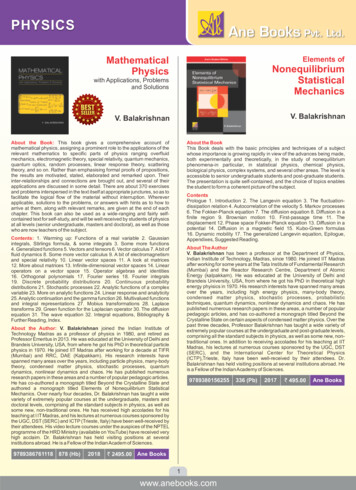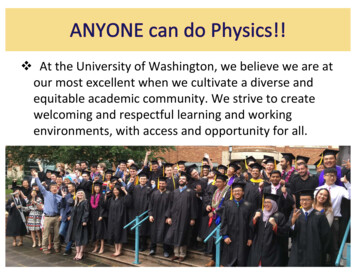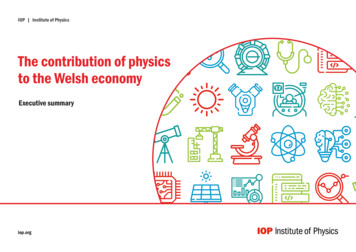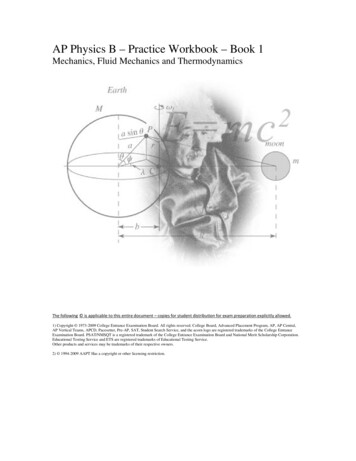
Transcription
PHYSICSMathematicalPhysicsElements ofNonequilibriumStatisticalMechanicswith Applications, Problemsand SolutionsV. BalakrishnanV. BalakrishnanAbout the Book: This book gives a comprehensive account ofmathematical physics, assigning a prominent role to the applications of therelevant mathematics to specific parts of physics ranging overfluidmechanics, electromagnetic theory, special relativity, quantum mechanics,quantum optics, random processes, linear response theory, scatteringtheory, and so on. Rather than emphasising formal proofs of propositions,the results are motivated, stated, elaborated and remarked upon. Theirinter-relationships and connections are brought out, and several of theirapplications are discussed in some detail. There are about 370 exercisesand problems interspersed in the text itself at appropriate junctures, so as tofacilitate the logical flow of the material without interruption. Whereverapplicable, solutions to the problems, or answers with hints as to how toarrive at them, along with relevant remarks, are given at the end of eachchapter. This book can also be used as a wide-ranging and fairly selfcontained text for self-study, and will be well received by students of physicsat all levels (senior undergraduate, masters and doctoral), as well as thosewho are now teachers of the subject.About the BookThis Book deals with the basic principles and techniques of a subjectwhose importance is growing rapidly in view of the advances being made,both experimentally and theoretically, in the study of nonequilibriumphenomena-in particular, in statistical physics, chemical physics,biological physics, complex systems, and several other areas. The level isaccessible to senior undergraduate students and post-graduate students.The presentation is quite self-contained, and the choice of topics enablesthe student to form a coherent picture of the subject.ContentsPrologue 1. Introduction 2. The Langevin equation 3. The fluctuationdissipation relation 4. Autocorrelation of the velocity 5. Markov processes6. The Fokker-Planck equation 7. The diffusion equation 8. Diffusion in afinite region 9. Brownian motion 10. First-passage time 11. Thedisplacement 12. Phase space Fokker-Planck equation 13. Diffusion in apotential 14. Diffusion in a magnetic field 15. Kubo-Green formulas16. Dynamic mobility 17. The generalized Langevin equation, Epilogue,Appendixes, Suggested Reading.Contents: 1. Warming up: Functions of a real variable 2. Gaussianintegrals, Stirlings formula, & some integrals 3. Some more functions4. Generalized functions 5. Vectors and tensors 6. Vector calculus 7. A bit offluid dynamics 8. Some more vector calculus 9. A bit of electromagnetismand special relativity 10. Linear vector spaces 11. A look at matrices12. More about matrices 13. Infinite-dimensional vector spaces 14. Linearoperators on a vector space 15. Operator algebras and identities16. Orthogonal polynomials 17. Fourier series 18. Fourier integrals19. Discrete probability distributions 20. Continuous probabilitydistributions 21. Stochastic processes 22. Analytic functions of a complexvariable 23. More on analytic functions 24. Linear response and analyticity25. Analytic continuation and the gamma function 26. Multivalued functionsand integral representations 27. Mobius transformations 28. Laplacetransforms 29. Green function for the Laplacian operator 30. The diffusionequation 31. The wave equation 32. Integral equations, Bibliography &Further Reading, Index.About The AuthorV. Balakrishnan has been a professor at the Department of Physics,Indian Institute of Technology, Madras, since 1980. He joined IIT Madrasafter working for some years at the Tata Institute of Fundamental Research(Mumbai) and the Reactor Research Centre, Department of AtomicEnergy (kalpakkam). He was educated at the University of Delhi andBrandeis University, USA, from where he got his PhD in theoretical highenergy phyisics in 1970. His research interests have spanned many areasover the years, including high energy physics, many-body theory,condensed matter physics, stochastic processes, probabilistictechniques, quantum dynamics, nonlinear dynamics and chaos. He haspublished numerous research papers in these areas, a number of popularpedagogic articles, and has co-authored a monograph titled Beyond theCrystalline State on certain aspects of condensed matter physics. Over thepast three decades, Professor Balakrishnan has taught a wide variety ofextremely popular courses at the undergraduate and post-graduate levels,comprising all the standard subjects in physics, as well as some new, nontraditional ones. In addition to receiving accolades for his teaching at IITMadras, his lectures at numerous courses sponsored by the UGC, DST(SERC), and the International Center for Theoretical Physics(ICTP),Trieste, Italy have been well-received by their attendees. Dr.Balakrishnan has held visiting positions at several institutions abroad. Heis a Fellow of the Indian Academy of Sciences.About the Author: V. Balakrishnan joined the Indian Institute ofTechnology Madras as a professor of physics in 1980, and retired asProfessor Emeritus in 2013. He was educated at the University of Delhi andBrandeis University, USA, from where he got his PhD in theoretical particlephysics in 1970. He joined IIT Madras after working for a decade at TIFR(Mumbai) and RRC, DAE (Kalpakkam). His research interests havespanned many areas over the years, including particle physics, many-bodytheory, condensed matter physics, stochastic processes, quantumdynamics, nonlinear dynamics and chaos. He has published numerousresearch papers in these areas and a number of popular pedagogic articles.He has co-authored a monograph titled Beyond the Crystalline State andauthored a monograph titled Elements of Nonequilibrium StatisticalMechanics. Over nearly four decades, Dr. Balakrishnan has taught a widevariety of extremely popular courses at the undergraduate, masters anddoctoral levels, comprising all the standard subjects in physics, as well assome new, non-traditional ones. He has received high accolades for histeaching at I IT Madras, and his lectures at numerous courses sponsored bythe UGC, DST (SERC) and ICTP (Trieste, Italy) have been well-received bytheir attendees. His video lecture courses under the auspices of the NPTELprogramme of the HRD Ministry (available on YouTube) have received veryhigh acclaim. Dr. Balakrishnan has held visiting positions at severalinstitutions abroad. He is a Fellow of the Indian Academ of Sciences.9789386761118 878 (Hb)20189789380156255 2495.00 Ane Books1www.anebooks.com336 (Pb)2017 495.00Ane Books
PHYSICSMathematicalBiophysicsTopics inMathematicalPhysicsRubin, Andrew,Riznichenko, GalinaHarish ParthasarathyAbout the Book: There exist several textbooks and researchmonographs on mathematical physics but this book stands out as it unifiesmathematical physics with engineering applications by including topicssuch as Random Processes in addition to physical interpretations ofmathematical models. The development of mathematical tools as well astheir application to the solution of physical and engineering problems gohand in hand in this book. The topics covered in this book include CircuitTheory and Nonlinear Systems, Random Processes, DifferentialEquations, Classical Mechanics, Quantum Mechanics, Fluid Dynamics,Electrodynamics, relativity general signal theory and group theory. Theselection of problems in each section illustrates how the mathematicaltechniques developed in the sequel under topics like Differential Equationsand group theory are applied to problems in theoretical physics andengineering. DSP implementations of equations occurring in theoreticalphysics has also been given some weightage in this book.In the sections on Random Processes and Signal Theory, Theory ofNonlinear Filtering has been introduced besides including moreelementary properties of random variables and random processes andtools like the characteristic function and moment generating function foranalyzing random phenomena. "In the section on Quantum Mechanics, Quantum Stochastic Calculus hasbeen introduced. DSP implementations of the Schrodinger wave equationand relativistic wave equations in an electromagnetic field are alsodiscussed.Some other features of this book include a good discussion of the KerrMetric corresponding to a rotating blackhole, methods for implementingalgorithms of quantum computation and quantum information usingMATLAB, basic problems of quantum scattering theory and stochasticprocesses in fluid dynamics. It is hoped that this book will be welcomed byundergraduates who are stepping into postgraduate research as well as byprofessional researchers in the field of theoretical physics andengineering.Contents: 1. Circuit Theory, 2. Classical Mechanics, 3. Electrodynamics,4. Quantum Mechanics, 5. Differential Equations, 6. Random Process,7. Relativity, 8. General Signal Theory, 9. Signal and Systems, 10. FluidDynamics, 11. Linear Algebra, 12. Group Theory, 13. MATLAB Problems,14. Partial Differential Equations, 15. Quantum Computation,16. Experiments for Analog and Digital Communication Laboratory,17. Miscellaneous problems and remarks on Signal Processing in PhysicalModels.About the Author: An IIT Kanpur graduate, Dr. Harish Parthasarathycompleted his research at IIT Delhi in the field of Design of Algorithm forNonlinear Spectral Analysis of Signals. Thereafter the author worked as apost-doctoral visiting fellow at the Indian Institute of Astrophysics,Bangalore.The author started his illustrious teaching career as Assistant Professor atIIT, Bombay where he taught an undergraduate course on Circuits andSystems and a post-graduate course on Adaptive Filters. As a visitingfaculty at the IIT, Kanpur, he taught a post-graduate course on AntennaAnalysis & Synthesis besides tutoring an undergraduate course on LinearAlgebra with Adaptive Filter applications.Since 2000 Dr. Parthasarathy, Asst. Professor, is teaching undergraduatecourses on Circuits and Systems and Electromagnetic Theory and apostgraduate course on Digital and Statistical Signal Processing at NetajiSubhas Institute of Technology (NSIT), New Delhi.9788180521843766 (Hb)2007 995.00About the BookThis book presents concise descriptions and analysis of the classical andmodern models used in mathematical biophysics. The authors ask thequestion "what new information can be provided by the models that cannotbe obtained directly from experimental data?" Actively developing fieldssuch as regulatory mechanisms in cells and subcellular systems andelectron transport and energy transport in membranes are addressedtogether with more classical topics such as metabolic processes, nerveconduction and heart activity, chemical kinetics, population dynamics, andphotosynthesis. The main approach is to describe biological processesusing different mathematical approaches necessary to revealcharacteristic features and properties of simulated systems. With theemergence of powerful mathematics software packages such as MAPLE,Mathematica, Mathcad, and MatLab, these methodologies are nowaccessible to a wide audience.ContentsGrowth and Catalysis Models, Oscillations oscillations, Rhythms, andChaos chaos in Biological Systems, Spatiotemporal Self-Organizationself-organization of Biological Systems, Model of Impact of a WeakElectric Field on Nonlinear System of Transmembrane Ion Transportpotential electric potential transmembrane ion flux, Oscillations andPeriodic Space Structures oscillations and periodic space structures of pHand Electric Potential Along the Cell Membrane of Algae Chara corallina,Models of Morphogenesis morphogenesis, Autowave Processesautowave process , Nerve Pulse Propagation nerve pulse propagation,and Heart Activity heart activity wave propagation potential propagation,Nonlinear Models of DNA Dynamics DNA dynamics, Models ofPhotosynthetic Electron Transport: Electron Transfer in a MultienzymeComplex multienzyme complex, Kinetic Model of Interaction of TwoPhotosystems, Detailed Model of Electron Transfer in PSII, GeneralizedKinetic Model of Primary Photosynthetic Processes photosynthesis kineticmodels, Method of Direct Multiparticle Simulation of Protein Interactionsmultiparticle simulations, Modeling of Protein Complex Formation inSolution with Diffusion and Electrostatic Interactions protein interactionscomplex formation, Modeling of Protein Interactions in PhotosyntheticMembrane photosynthetic membrane membrane photosynthetic proteininteractions photosynthetic membrane thylakoid membrane membranethylakoid, Spatiotemporal Evolution of Electrochemical Potential Δμ H inPhotosynthetic Membrane potential transmembrane potentialelectrochemical.9781461487012 295 (Hb)Ane Books2www.anebooks.com2014 139.99Springer
PHYSICSStatisticalMechanicsProblems onStatisticalMechanicsD.A.R DalvitJ FrastaiIan LawrieSchwabl, FranzAbout the BookThe completely revised new edition of the classical book on StatisticalMechanics covers the basic concepts of equilibrium and non-equilibriumstatistical physics. In addition to a deductive approach to equilibriumstatistics and thermodynamics based on a single hypothesis - the form ofthe microcanonical density matrix - this book treats the most importantelements of non-equilibrium phenomena. Intermediate calculations arepresented in complete detail. Problems at the end of each chapter helpstudents to consolidate their understanding of the material. Beyond thefundamentals, this text demonstrates the breadth of the field and its greatvariety of applications. Modern areas such as renormalization grouptheory, percolation, stochastic equations of motion and their applicationsto critical dynamics, kinetic theories, as well as fundamentalconsiderations of irreversibility, are discussed. The text will be useful foradvanced students of physics and other natural sciences; a basicknowledge of quantum mechanics is presumed.About the BookThis series of books in physics and related subjects is designed to meet theneeds of graduate students. Although not primarily research texts, thebooks point out the direction which research is currently taking and where itis expected to lead. They therefore serve as introductory surveys forresearch students, who might otherwise be faced with the formidable taskof acquainting themselves with a research topic by reading sophisticatedresearch texts.A thorough understanding of statistical mechanics depends strongly on theinsights and manipulative skills that are acquired through the solving ofproblems. This book provides over 120 problems with model solutions,illustrating both basic principles and applications ranging from solid-statephysics to cosmology. Advanced undergraduate and graduate students ofphysics and teachers of statistical mechanics couses, will find here aninvaluable source of interesting problems to complement those found instandard textbooks.ContentsBasic Principles, Equilibrium Ensembles, Thermodynamics, IdealQuantum Gases, Real Gases, Liquids, and Solutions, Magnetism, PhaseTransitions, Scale Invariance, Renormalization Group Theory, andPercolation, Brownian Motion, Equations of Motion, and the FokkerPlanck Equations, The Boltzmann Equation, Irreversibility and theApproach to EquilibriumAn introductory chapter provides a summary of the basic concepts andresults that are needed to tackle the problems, and also serves to establishthe notation that is used throughout the book. The problems themselvesoccupy five further chapters, in which readers are invited to develop theirunderstanding progressively from the simpler aspects of thermodynamicsand equilibrium statistical ensembles to the more challenging ideasassociated with strongly interacting systems and non-equilibriumprocesses. Comprehensive solutions to all of the problems are designed toillustrate efficient and elegant problem-solving techniques. Whereappropriate, they incorporate extended discussions of the points ofprinciple that arise in the course of the solutions. Finally an appendixprovides a useful miscellany of mathematical hermodynamicsStatistical EnsemblesQuantum StatisticsInteracting SystemsNonequilibrium Methods and Transport ProcessesAppendix, Useful Formulae9780750305204286 (Hb)2015 2995.00 CRC Press3www.anebooks.com578 (Pb)2006 84.10Springer
PHYSICSNonequilibriumStatistical PhysicsStatisticalPhysicsLinear Irreversible ProcessesIncluding ApplicationsTo Condensed MatterClaudine HermannNoelle PottierAbout the BookStatistical Physics bridges the properties of a macroscopic system and themicroscopic behavior of its constituting particles, otherwise impossibledue to the giant magnitude of Avogadro's number. Numerous systems oftoday's key technologies, such as semiconductors or lasers -- aremacroscopic quantum objects; only statistical physics allows forunderstanding their fundamentals. Therefore, this graduate text alsofocuses on particular applications such as the properties of electrons insolids with applications, and radiation thermodynamics and thegreenhouse effect.About the BookWhile systems at equilibrium are treated in a unified manner through thepartition function formalism, the statistical physics of out-of-equilibriumsystems covers a large variety of situations that are often without apparentconnection. This book proposes a unified perspective on the whole set ofsystems near equilibrium: it brings out the profound unity of the laws whichgovern them and gathers a large number of results usually fragmented inthe literature. The reader will find in this book a pedagogical account of thefundamental results: physical origins of irreversibility, fluctuationdissipation theorem, Boltzmann equation, linear response, Onsagerrelations, transport phenomena, Langevin and Fokker-Planck equations.The book's comprehensive organisation makes it valuable both as atextbook about irreversible phenomena and as a reference book forresearchers.ContentsIntroductionGlossary1. Statistical Description of Large Systems Postulates2. The Different Statistical Ensembles. General Methods3. Thermodynamics and Statistical Physics4. The Ideal Gas5. Indistinguishability, the Pauli Principle6. General Properties of the Quantum Statistics7. Free Fermions Properties8. Elements of Bands Theory and Crystal Conductivity9Bosons: Helium 4, Photons, Thermal RadiationSolving Excercises and Problems of Statistical PhysicsUnits and Physical ConstantsA few useful formulaeExcercises and ProblemsSolution of the Excercises and ProblemsIndex"Its strength no doubt lies in showing how a large variety of subjects closeto experimental interest are connected to a basis of fundamental statisticalphysics. an excellent book that is likely to keep its value when fashionchanges." --Henk Hilhorst, Universite Paris-Sud"An extremely thorough, complete and well written reference on all wellestablished aspects of non equilibrium statistical physics andcorresponding linear irreversible processes. The book grew out of lecturesgiven over many years at the graduate level in Paris, and is verypedagogical, providing cases and easily accessible knowledge in wellwritten chapters." --Hubert Saleur, University of Southern CaliforniaContents1. Random variables and random processes2. Linear thermodynamics of irreversible processes3. Statistical description of out-of-equilibrium systems4. Classical systems: reduced distribution functions5. The Boltzmann equation6. Transport coefficients7. From the Boltzmann equation to the hydrodynamic equations8. The Bloch-Boltzmann theory of electronic transport9. Master equations10. Brownian motion: the Langevin model11. Brownian motion: the Fokker-Planck equation12. Linear responses and equilibrium correlations13. General linear response theory14. The fluctuation-dissipation theorem15. Quantum theory of electronic transport16. Thermal transport coefficientsIndex9780199591138512 (Pb)2010 995.009788184893212Oxford4www.anebooks.com296 (Pb)2009 795.00Ane Books
PHYSICSStatisticalField TheoryEssentials ofNonlinear OpticsAn Introduction to Exactly SolvedModels in Statistical PhysicsY.V.G.S. MurtiC. VijayanGiuseppe MussardoAbout the BookThis book provides a thorough introduction to the fascinating world ofphase transitions as well as many related topics, including random walks,combinatorial problems, quantum field theory and S-matrix. Fundamentalconcepts of phase transitions, such as order parameters, spontaneoussymmetry breaking, scaling transformations, conformal symmetry, andanomalous dimensions, have deeply changed the modern vision of manyareas of physics, leading to remarkable developments in statisticalmechanics, elementary particle theory, condensed matter physics andstring theory. This self-contained book provides an excellent introductionto frontier topics of exactly solved models in statistical mechanics andquantum field theory, renormalization group, conformal models, quantumintegrable systems, duality, elastic S-matrix, thermodynamics Betheansatz and form factor theory. The clear discussion of physical principles isaccompanied by a detailed analysis of several branches of mathematics,distinguished for their elegance and beauty, such as infinite dimensionalalgebras, conformal mappings, integral equations or modular functions.About the BookNonlinear optical interaction of matter with intense optical fields plays a keyrole in emerging photonic technologies in the areas of photonics. Recentreports on new kinds of materials exhibiting novel forms of physicalmechanisms and innovative proposals for device applications haveencouraged further research in the field. An increasing awareness andexposure to the vast scope of nonlinear optics call for a clearunderstanding of the basic physics involved with an introduction towardapplications.The available book on nonlinear optics are of quite a wide variety in termsof content, style, topic coverage and depth of treatment. While most ofthese books are excellent resources for the researchers, there is a strongneed for books appropriate for presenting the subject at the undergraduateor postgraduate levels in Universities. This book has emerged from anattempt to address the requirement of presenting the subject at collegelevel. A one-semester course covering the essentials can effectively bedesigned based on this. Care has been taken to include rigorous featuressuch as:Besides advanced research themes, the book also covers many basictopics in statistical mechanics, quantum field theory and theoreticalphysics. Each argument is discussed in great detail, paying attention to anoverall coherent understanding of physical phenomena. Mathematicalbackground is provided in supplements at the end of each chapter, whenappropriate. The chapters are also followed by problems of different levelsof difficulty. Advanced undergraduate and graduate students will find a richand challenging source for improving their skills and for accomplishing acomprehensive learning of the many facets of the subject.-elucidation of relevant basic principles of physics -clear exposition of theideas involved at an appropriate level -coverage of the physicalmechanisms of nonlinearity -update on physical mechanisms andemerging photonic materials and -emphasis on the experimental study ofnonlinear interactionsThe topics covered include quantum mechanics of nonlinear interaction ofmatter and radiation, formalism and phenomenology of nonlinear wavemixing processes, optical phase conjugation and applications, selffocusing and self phase modulation and their role in pulse modification,nonlinear absorption mechanisms and optical limiting applications,photonic switching and bistability, and physical mechanisms leading tononlinear response in a variety of materials.Contents1. Introduction2. One-dimensional systems3. Approximate solutions4. Duality of two-dimensional Ising model5. Combinatorial solutions of the Ising model6. Transfer matrix of the two-dimensional Ising model7. Quantum field theory8. Renormalization group9. Fermionic formulation of the Ising model10. Conformal field theory11. Minimal conformal models12. Conformal field theory of free Bosonic and Fermionic fields13. Conformal field theories with extended symmetries14. The arena of conformal models15. In the vicinity of the critical points16. Integrable quantum field theories17. S-matrix theory18. Exact S-matrices19. Thermodynamics Bethe Ansatz20. Form factors and correlation functions21. Non-integrable aspectsIndex9780198066835778 (Pb)2010 995.00Contents1. From Optics to Photonics 2. A Phenomenological View of NonlinearOptics 3. Symmetry and Susceptibility Tensors 4. Calculation of NonLinear Susceptibilities 5. Nonlinear Wave Mixing Processes 6. OpticalPhase Conjugation and Bistability 7. Self Focusing, Phase Modulation andPulse Shaping 8. Mechanisms and Materials, Bibliography, References,IndexAbout the AuthorY.V.G.S. Murti joined the premier institution of IIT Madras following a brightacademic career, where his teaching and research activities spanned overa few decades. Prof. Murtis condensed Matter research includedexperimental and theoretical investigations addressing problems on latticedefects and related transport and optical phenomena. Establishing aschool of research on Photonics, he led work on experiments on NonlinearWave Mixing as well as on theorectical evaluation of Optical Nonlinearitiesof Color centers.C.VIjayan has done his M.Sc. and Ph.D in physics from the Indian Instituteof Technology, Madras, Chennai. His early work includes Solid StateTransport Phenomena and Photonic Memories. Over the last twodecades, he has been actively pursuing research on nonlinear opticalproperties of Novel Materials. A professor of physics at the Indian Instituteof Technology, Madras, he heads the Photonics laboratory directing workof Quantum Confined Materials and Nanophotonic Materials.Oxford97893836566395www.anebooks.com204 (Pb)2016 350.00Ane Books
PHYSICSFourier OpticsA Textbook ofOpticsandComputationalImagingnewSuresh ChandraMohit Kumar SharmaKedar KhareAbout the BookOptics is a part of electromagnetic spectrum that consists of gamma rays,x-rays, ultra-violet radiation, visible radiation, infrared radiation,microwaves, radio waves. This book is an effort to explain this broadspectrum of Optics in a student friendly way. It covers the entire syllabi ofthe undergraduate courses being taught at the Indian Universitiesthroughout the country. Adequate details of mathematical expressionshave been given to help students understand the subject matter. Each andevery topic is explained in a simple and lucid language with the help ofsolved problems. Exercises with MCQs have been given at the end of eachchapter for self assessment.About the BookThis book provides an introduction to Fourier Optics in the light of newdevelopments in the area of Computational Imaging over the last couple ofdecades. Imaging systems combining Fourier Optics principles and ideason image reconstruction are increasingly showing superior imagingperformance and are being used regularly in scientific research and in dayto-day imaging applications. This book is intended to provide a basicbackground of the exciting area of Computational Imaging to advancedundergraduate and post-graduate students in Physics, ElectricalEngineering, and Mathematics who may wish to work with imagingsystems in their future careers.Contents1. Reflection 2. Refraction 3. Cardinal Points 4. Interference 5. FresnelDiffraction 6. Fraunhoffer Diffraction 7. Polarization 8. Lasers andHolography 9. Fiber Optics, Bibliography, IndexSalient features of the bookAbout the AuthorsProf. (Dr) Suresh Chandra is presently Deputy Director & ProfessoratAmity Center for Astronomy & Astrophysics, Amity Institute of AppliedSciences, Amity University, Noida. Earlier, he was Director, School ofPhysical Sciences, SRTM University, Nanded (Maharashtra) and Director,School of Physical Sciences, and Dean of Students in SMVD University,Katra (J&K). He is Fellow of the Royal Astronomical Society (London),Fellow of the Maharashtra Academy of Sciences (Pune), AssociateMember of the Third World Academy of Sciences (Italy), Fellow of theAlexander von Humboldt Foundation (Germany), Life Member of theInternational Astronomical Union and Life Member of several othernational academic bodies.Dr. Mohit Kumar Sharma is National Postdoctoral Fellow of SERB, DST,New Delhi at Amity Center for Astronomy & Astrophysics, Amity Institute ofApplied Sciences, Amity University, Noida. Earlier, he worked as Asstt.Prof. in ITM University, Gwalior. He has received the Young ScientistAward (2014) of Indian Science Congress Association, Kolkata. A brilliantstudent throughout, he earned his Ph.D. (Physics)from Jiwaji University,Gwalior. He is co-author of eight textbooks and has published 22 researchpapers in the journals of international repute. He is life member ofAstronomical Society of India; Indian Science Congress Association,Kolkata; Indian Society of Atomic & Molecular Physics; Indian Associationof Physics Teachers; Astro-chemistry Society of India.322 (Hb)2018In-depth discussion of mathematical methods such as Fourieranalysis, linear systems theory, random processes and optimizationbased image reconstruction techniques required for understandingthe working of computational imaging systems. Discussion of topics in Fourier optics, e.g. diffraction phenomena,coherent and incoherent imaging systems, and some aspects ofcoherence theory. Description of several system ideas combining optical hardwaredesign and image reconstruction algorithms for giving the readers afeel for current research trends in Computational ImagingContents1 Introduction 2 Fourier series and transform 3 Sampling Theorem4 Operational introduction to Fast Fourier Transform 5 Linear systemsformalism and introduction to inverse problems in Imaging 6 Constrainedoptimization methods for image
Mathematical Physics with Applications, Problems and Solutions V. Balakrishnan 9789386761118 878 (Hb) 2018 2495.00 Ane Books About the Book: Contents: About the Author: This book gives a comprehensive account of mathematical physics, assigning a prominent role to the applications of the relevant mathematics to specific parts of physics .










